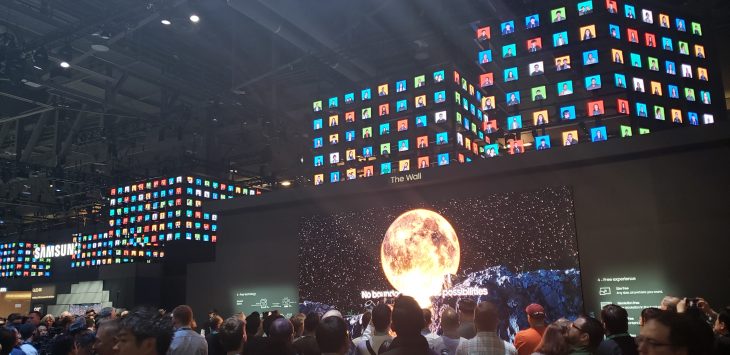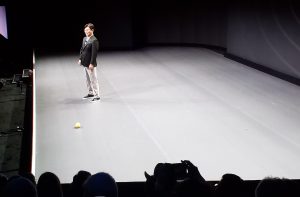
By John Bugailiskis
LAS VEGAS – It wasn’t too long ago that media day at CES (the day before the show starts) was all about manufacturers boasting about having the biggest and brightest TV screens. Not this year.
Both Samsung and LG, for example, instead focused their presentations on how artificial intelligence, 5G and robotics can be used to improve the human condition. LG spoke about how AI can have a positive impact on the “human experience” while Samsung heralded this decade will be the “age of experience.”
Opening CES keynote speaker H.S. Kim, president and CEO of Samsung, said the decade to come will be one of “human-centric innovation that seamlessly combines hardware and software to create personalized experiences that make life more convenient, more enjoyable, and more meaningful.”
He went on to describe how consumers are increasingly prioritizing experiences over products, and “looking to buy convenience, peace of mind and enjoyment.” The Age of Experience is a product of this shift – an age in which increasingly innovative products foster seamless experiences and memorable moments. “At the center is us,” said Kim. “People. The way we interact with our world is what drives this evolution.”
“This is Samsung’s mission,” Kim continued, “to create unforgettable moments that make your lives better and make a difference for humanity.”
While it was refreshing to hear a senior executive at a tech company talk about experiences, rather than urging you to buy their 8K TV because your two year old 4K model is now outdated, it wasn’t made clear how his vision will translate into tangible products during his presentation.
Instead, Kim’s keynote was more of a general update on Samsung’s advances in intelligent robotics, AI, 5G and edge computing. What was missing was any mention of timelines when the advances mentioned that are to help capture and share our special moments will be available.
An example of this is when a yellow ball (pictured), about the size of a grapefruit, started rolling around the huge stage and then began to follow Kim. Called “Ballie”, Kim referred to it as a “life companion” since it’s designed to understand you, support you, react to your needs and “actively helpful around the house.” He showed a brief video of Ballie interacting with a dog and helping clean up a mess the dog made by instructing a robot vacuum cleaner to turn on.
But there were no details on price points, or specification, or even when it might become available.
Kim then moved onto to explaining that the core of Samsung’s human-centered vision is personalized care, enhancing the health and well-being of consumers by satisfying their individual needs.
Sebastian Seung, executive vice president and chief research scientist at Samsung explained that Ballie has its on-device AI capabilities that enable it to be a fitness assistant and a mobile interface that seeks solutions for people’s changing needs. Samsung insisted it can do all that while maintaining stringent data protection and privacy standards.
“Samsung will never share your data with third parties without prior and direct consent from you,” added Kim.
“On-device AI puts you in control of your information and protects your privacy, while still delivering the power of personalization.” – H.S Kim, Samsung
“We believe AI is the future of personalized care,” said Seung. “We see on-device AI as central to truly personalized experiences. On-device AI puts you in control of your information and protects your privacy, while still delivering the power of personalization.”
Samsung also highlighted how it is collaborating with health care company Kaiser Permanente to develop a home-based, virtual cardiac rehabilitation solution that pairs a Samsung smartwatch with a smartphone via Bluetooth. Samsung’s HeartWise application sends reminders to the patient to exercise, collects activity data, and continuously displays the patient’s heart rate during workouts. This data is automatically uploaded via the smartphone to the patient’s chart so that clinicians, case managers and physical therapists can track the patient’s progress and engage with them accordingly.
The program enables users to partake in cardiac rehabilitation at home without taking time out of their everyday lives to travel to a hospital or medical clinic. Going forward, Samsung says it will continue to develop human-centric healthcare solutions that cater to the unique needs of the individuals who rely on them.
Samsung also offered a peek into the future home. Federico Casalegno, chief design innovation officer of Samsung Design Innovation Center, stated the home will offer unique, immersive experiences with cutting-edge innovations like AI-powered sensors and data analysis: “As a living organism, the intelligent home will be a deeply personal space, tailoring experiences for each of us, according to our personal needs.”
Casalegno highlighted how spatial boundaries of the physical and digital worlds are dissolving, transforming living spaces like a kitchen into an art gallery, yoga studio or other forms of imaginable space.
He also led a demonstration of Samsung’s GEMS (gait enhancing and motivating system) technology. The demonstration showed how consumers can use augmented reality glasses to work out with a virtual personal trainer, climb a mountain or walk underwater, from the comfort of their living room. When the workout is completed, GEMS aggregates and analyzes results to give personalized action recommendations.
Kim also took the opportunity to outline Samsung’s smart cities vision, where intelligent systems enabled by smart devices, platforms and data, will make “city life much safer and easier.”
Emily Becher, senior vice-president and head of Samsung NEXT Global took to the stage to explain how “smart cities that utilize AI, IoT and 5G will transform how we interact with the surrounding environment in ways that maximize convenience and enjoyment”.
With IoT technology expanding its reach beyond the home to all types of buildings, Samsung’s core vision lies in saving energy, cutting down emissions and helping to achieve sustainability as populations grow she added.
In realizing the goal of creating a smart city with smart buildings, Samsung emphasized the importance of open collaboration. The company is working towards building partnerships with builders and property managers like Greystar Real Estate Partners, a U.S.-based global real estate developer, with which it will devise smart building solutions. “With smart buildings, the residents’ experience will get smarter, more efficient, more effective, so they utilize less energy,” said Bob Faith, chairman and CEO of Greystar.
Samsung also demonstrated how the combination of 5G, edge computing and AI will transform the urban transportation experience. Becher shared the company’s vision to lead the new era of vehicles, with 5G technology enabling vehicle-to-everything communication, which will seamlessly connect cars to the rest of the city.
Becher added that smart cities combined with 5G will be able to provide experiences “unimaginable a few years ago to communities.” She added, “Faster and easier digital connection with each other will strengthen our sense of community and create entirely new forms of interaction.”
Concluding his 2020 CES keynote address, H.S. Kim said the three key areas of importance for the company going forward are: security and privacy, technology for good, and citizenship.



